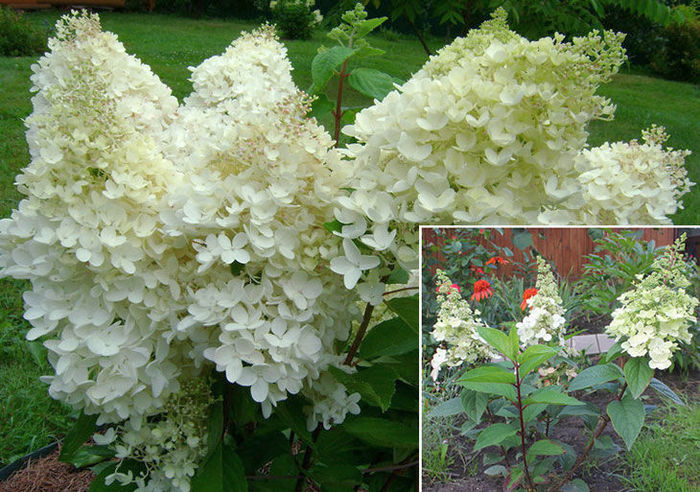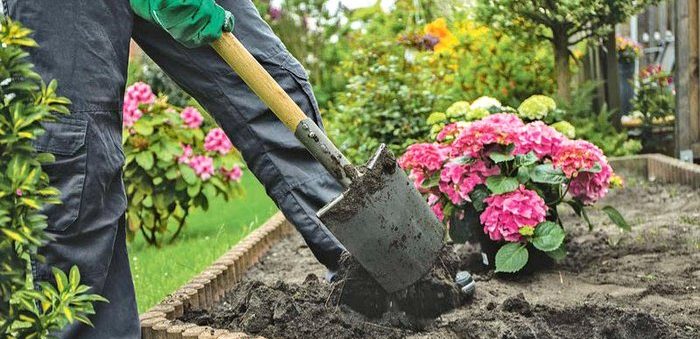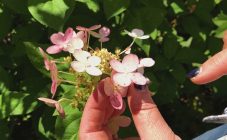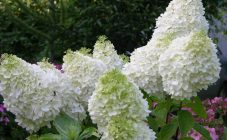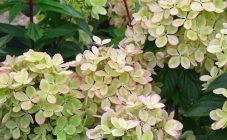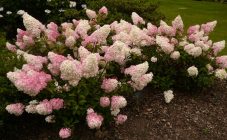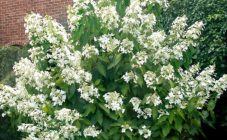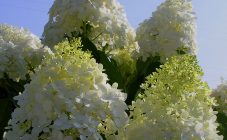Panicle hydrangeas are most commonly used for cultivation in Russia. They have good winter hardiness and are successfully grown in regions with severe winters. Some varieties tolerate winters quite well in Siberia. And plants damaged by frost have the ability to quickly recover after winter and delight with their flowering.
Hydrangea paniculata Candlelight (hydrangea Candlelight, hydrangea Kendl light) is a new variety of Dutch selection. Deciduous shrub with a dense compact crown, 1-1.2 m high, crown diameter up to 2 m. The name translates into Russian as "light of a burning candle". The variety is decorative due to its abundant flowering. The inflorescences are of a rare color for hydrangeas. During the blooming period, the flowers are greenish, then they acquire a golden hue, by autumn, shades of red appear in the inflorescences.
In 2013, the Candlelight Hydrangea paniculata (in some sources - the Candle Light hydrangea or even the Candy Light) was awarded a silver medal at the Plantrium exhibition.
Hydrangea Candelite: variety description
The height of the bush reaches an average of 1.5 meters. The height of the trunk is 60 cm. The crown is spreading, round, dense. Shoots are strong, durable, beautiful burgundy color. The inflorescences first have a yellow-green color, then the flowers acquire a golden gamut, and by autumn it changes to pink and even red shades. The plant is decorative throughout the season. Blooms profusely on the shoots of the current year, from July to October. Inflorescences are very large, conical, consisting of small fruiting and multiple larger sterile flowers.
Leaves are elliptical, deep green or dark green, with noticeable venation, dark green. The edge of the leaf is serrated. Fruits are very small capsules with seeds, ripening in late August - September. During the growing season, the shrub is picky about watering and needs additional feeding. Light partial shade is ideal for growing Candy Light, although the plant does well in the sun. The soil should be light, moderately moist, drained, and acidic.
The plant is highly frost-resistant. The flowering is lush, long lasting - from July to frost. Does not lose its decorative effect in autumn. Dried inflorescences are good for creating winter bouquets.
Sandlelight hydrangea prefers fertile and well-drained soil. Sunny areas are more suitable for her, but it can bloom in partial shade. The variety is winter-hardy, but it is recommended to cover young plants for the first 2-3 winters.
In order for Hortense Candy Light to please for a long time with lush and beautiful flowers, it is necessary to plant it correctly and subsequently take care of it. The place for planting hydrangeas is chosen sunny, protected from drafts. The soil for planting must be fertile and acidic. When the soil is alkalized, the plant loses its decorative effect. Panicle hydrangea develops poorly in sandy soil.
Landing
Hydrangea Candlelight can be grown from seeds, cuttings, seedlings.
The best planting material for all types of hydrangeas is four to five year old seedlings. Such seedlings are able to please with flowering already in the year of planting. It is necessary to plant in the spring, before the sap flow begins.You can plant hydrangea in the fall, but there is a risk that it will not have time to take root well.
A less popular way of propagating hydrangeas is by seed. This method is relevant for growing rare varieties when it is difficult to find other planting material. In this case, the plant will bloom in a few years. On average, it will take 2-3 years to wait. Most often, when propagating by seeds, the seedling method is used, but it can also be sown in open ground.
It should also be noted that adult plants, as a rule, have strong immunity, but seedlings need to prevent various diseases. For this, they are treated with drugs such as Karbaphos, Fitoverm.
It is better to prepare the hydrangea pit in advance. It should be spacious. For group planting, the distance between the bushes should be 2.5-3 m. Before planting, the land must be watered abundantly so that it is well saturated. Hydrangea is very demanding on soil moisture.
The planting hole is filled with a mixture of fertile soil, sand, peat and humus (2: 1: 2: 1), adding 25 g of urea and potassium sulfate, 65 g of superphosphate to it. The soil should settle. The root system of the seedling is straightened and the seedling is carefully added so that the root collar is just above the ground. The seedling is watered abundantly. The trunk circle is mulched with needles, leaf humus or sour peat. Immediately after planting, it is advisable to shade the plant from bright sunlight.
Care
Hydrangea is a culture that gratefully responds to care. It is hygrophilous, it is necessary to ensure regular watering, especially if the summer is dry.
Lush flowering requires additional fertilizing. The hydrangea is usually fed four times during the season. In early spring, organic fertilizers (a solution of mullein, horse manure, or bird droppings) are applied to the soil. The second feeding is carried out during the period of bud formation. Add a solution of 35 g of potassium sulfate, 35 g of superphosphate and 25 g of urea in 10 liters of water per 1 m². In the middle of summer, hydrangea is fertilized with complex mineral fertilizers. The amount and concentration of fertilizers applied must correspond to the parameters recommended by the manufacturer. In the fall, phosphate-potassium fertilizers are used for feeding. They help to increase frost resistance, as well as to restore the strength of the plant after abundant flowering.
For lush flowering, correct pruning of hydrangea is also necessary, which is carried out at the end of March.
The bush is formed from 5 to 10 strong shoots, shortening them to 3-5 buds. For old bushes, rejuvenating pruning is carried out, shortening all shoots to 6-7 cm from the ground.
Hydrangea is a long-lived flower, so you should immediately choose a place where the shrub will grow for at least 50 years. A permanent place is very important for the plant, since the shrub does not tolerate transplanting well.
Hydrangea paniculata is not ignored by both amateurs and professionals. Its high decorativeness attracts the attention of landscape designers. Hydrangea Candelite is equally attractive in single plantings and in combination with other plants. It looks very impressive in composition with evergreen perennials. The variety has a universal application. It can be recommended for planting in summer cottages and for use in urban areas (parks, alleys, the territory of administrative buildings). Florists use hydrangea to create bouquets.
All efforts to care for hydrangeas will certainly be rewarded with a long and mesmerizing flowering. This beauty will undoubtedly become a favorite in the garden.
